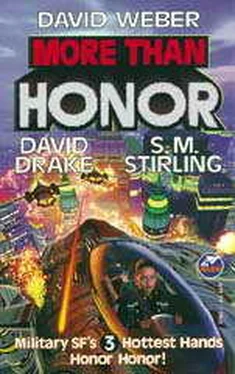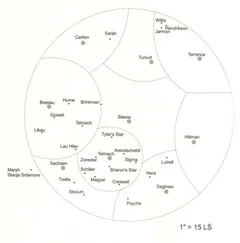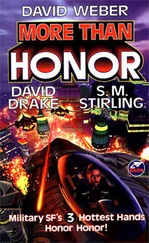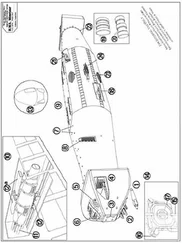David Weber - More Than Honor
Здесь есть возможность читать онлайн «David Weber - More Than Honor» весь текст электронной книги совершенно бесплатно (целиком полную версию без сокращений). В некоторых случаях можно слушать аудио, скачать через торрент в формате fb2 и присутствует краткое содержание. Жанр: Фантастика и фэнтези, на английском языке. Описание произведения, (предисловие) а так же отзывы посетителей доступны на портале библиотеки ЛибКат.
- Название:More Than Honor
- Автор:
- Жанр:
- Год:неизвестен
- ISBN:нет данных
- Рейтинг книги:3 / 5. Голосов: 1
-
Избранное:Добавить в избранное
- Отзывы:
-
Ваша оценка:
- 60
- 1
- 2
- 3
- 4
- 5
More Than Honor: краткое содержание, описание и аннотация
Предлагаем к чтению аннотацию, описание, краткое содержание или предисловие (зависит от того, что написал сам автор книги «More Than Honor»). Если вы не нашли необходимую информацию о книге — напишите в комментариях, мы постараемся отыскать её.
More Than Honor — читать онлайн бесплатно полную книгу (весь текст) целиком
Ниже представлен текст книги, разбитый по страницам. Система сохранения места последней прочитанной страницы, позволяет с удобством читать онлайн бесплатно книгу «More Than Honor», без необходимости каждый раз заново искать на чём Вы остановились. Поставьте закладку, и сможете в любой момент перейти на страницу, на которой закончили чтение.
Интервал:
Закладка:
Since .3 c (approx. 89,907.6 km./sec.) was the maximum velocity at which an "upward" translation into hyper-space could be made, the maximum initial velocity in hyper-space was .024 c (or 7,192.6 km./sec.). Making translation at speeds as high as .3 c was a rough experience and not particularly safe. The loss rate at .3 c was over 10%; dropping translation velocity to .23 c virtually eliminated ship losses in initial translation, and, since the difference in initial hyper velocity was less than 1,700 KPS, most captains routinely made translation at the lower speed. Even today, only military commanders in emergency conditions will make upward translation at .3 c . There is no safe upper speed on "downward" translations. That is, a ship may translate from hyper-space to normal-space at any hyper-space velocity without risking destruction. (Which is not to say that the crews enjoy the experience or that it does not impose enormous wear and tear on hyper generators.) Further, translation from one hyper band to a higher band (see below) may be made at any velocity up to and including .6 c . No vessel may exceed .6 c in hyper (.8 in normal-space) because radiation and particle shields cannot protect them or their passengers at higher velocities.
Once a vessel enters hyper, it is placed in what might be considered a compressed dimension which corresponds on a point-by-point basis to "normal-space" but places those points in much closer congruity. Hyper-space consists of multiple regions or layers—called "bands"—of associated but discrete dimensions. Dr. Radhakrishnan (who, after Adrienne Warshawski, is considered to have been humanity's greatest hyper-physicist) called the hyper bands "the back-flash of creation," for they might be considered echoes of normal-space, the consequence of the ultimate convergence of the mass of an entire normal-space universe. Or, as Dr. Warshawski once put it, "Gravity folds normal-space everywhere, by however small an amount, and hyper-space may be considered the 'inside' of all those little folds."
In practical terms, this meant that for a ship in hyper, the distance between normal-space points was "shorter," which allowed the vessel to move between them using a standard reaction drive at sublight speeds to attain an effective FTL capability. Even in hyper, ships were not capable of true faster-than-light movement; the relatively closer proximity of points in normal-space simply gave the appearance of FTL travel, which meant that as long as a vessel was dependent on its reaction drive and could not reach the higher hyper bands, its maximum apparent speed was limited to approximately sixty-two times that which the same vessel could have attained in normal-space.
Navigation, communication, and observation all are rendered difficult by the nature of hyper-space. Formed by gravitational distortion, hyper-space itself acts as a focusing glass, producing a cascade effect of ever more tightly warped space. The laws of relativistic physics apply at any given point in that space, but as a hypothetical observer looks "outward" in hyper-space, his instruments show a rapidly increasing distortion. At ranges above about 20 LM (359,751,000 km.) that distortion becomes so pronounced that accurate observations are impossible. One says "about 20 LM" because, depending on local conditions, that range may vary up or down by as much as 12%—that is, from 17.6 LM (316,580,880 km.) to 22.4 LM (or 402,921,120 km.). A hypership thus travels at the center of a bubble of observation from 633,161,760 to 805,842,240 km. in diameter. Even within that sphere, observations and measurements can be highly suspect; in effect, the "bubble" may be thought of as the region in which an observer can tell something is out there and very roughly where. Exact, precise observations and measurements are all but impossible above ranges of 5,000,000 to 6,000,000 km., which would make navigational fixes impossible even if there were anything to take fixes on.
This seemed to rule out any practical use of hyper-space until the development of the first "hyper log" (known as the "HL" by spacers) in 731 pd. The HL is analogous to the inertial guidance units first developed on Old Earth in the 20th century ce. By combining the input from extremely acute sensor systems with known power inputs to a vessel's own propulsive systems and running a continuous back plot of gravity gradients passed through, the HL maintains a real-time "dead reckoning" position. Early HLs were accurate to within no more than 10 LS per light-month, which meant that, in a voyage of 60 light-years, the HL position might be out by as much as two light-hours. Early hyper-space navigators thus had to be extremely cautious and make generous allowances for error in plotting their voyages, but current (1900 pd) HLs are accurate to within .4 light-second per light-month (that is, the HL position at the end of a 60 light-year voyage would be off by no more than 288 light-seconds or less than 5 light-minutes).
From the beginning of hyper travel, it was known that there were multiple hyper bands and that the "higher" the band, the closer the congruity between points in normal-space and thus the higher the apparent FTL speed, but their use was impractical for two major reasons. First, translation from band to band bleeds off velocity much as the initial translation. The bleed-off for each higher band is approximately 92% of the bleed-off for the next lowest one (that is, the alpha band translation reduces velocity by 92%; the beta band bleed-off is 84.64%; the velocity loss for the gamma band is 77.87%, etc.), but it still had to be made up again after each translation, and this posed an insurmountable mass requirement for any reaction drive.
The second problem was that the interfaces between any two hyper bands are regions of highly unstable and powerful energy flows, creating the "dimensional shear" which had destroyed so many early hyperships, and dimensional shear becomes more violent as band levels increase. Moreover, even the relatively "safe" lower bands which could be reliably reached were characterized by powerful energy surges and flows—currents, almost—of highly-charged particles and warped gravity waves. Adequate shielding could hold the radiation effects in check, but a grav shear within any band could rip the strongest ship to pieces.
Hyper-space grav waves take the form of wide, deep volumes of space, as much as fifty light-years across and averaging half their width in depth, of focused gravitational stress "moving" through hyper-space. Actually, the wave itself might be thought of as stationary, but energy and charged particles trapped in its influence are driven along it at light– or near-light-speed. In that sense, the grav wave serves as a carrier for other energies and remains motionless but for a (relatively) slow side-slipping or drifting. In large part, it is this grav wave drift which makes them so dangerous; survey ships with modern sensors can plot them quite accurately, but they may not be in the same place when the next ship happens along. The major waves in the more heavily traveled portions of the galaxy have been charted with reasonable accuracy, for sufficient observational data has been amassed to predict their usual drift patterns. In addition, most waves are considered "locked," meaning that their rate of shift is low and that they maintain effectively fixed relationships with other "locked" waves. But there are also waves which are not locked—whose patterns (if, in fact, they have patterns at all) are not only not understood but can change with blinding speed. One of the most famous of these is the Selkir Shear between the Andermani Empire and the Silesian Confederacy, but there are many others, and those in less well-traveled (and thus less well-surveyed) areas, especially, can be extremely treacherous.
Читать дальшеИнтервал:
Закладка:
Похожие книги на «More Than Honor»
Представляем Вашему вниманию похожие книги на «More Than Honor» списком для выбора. Мы отобрали схожую по названию и смыслу литературу в надежде предоставить читателям больше вариантов отыскать новые, интересные, ещё непрочитанные произведения.
Обсуждение, отзывы о книге «More Than Honor» и просто собственные мнения читателей. Оставьте ваши комментарии, напишите, что Вы думаете о произведении, его смысле или главных героях. Укажите что конкретно понравилось, а что нет, и почему Вы так считаете.












